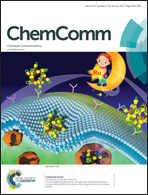The synergistic effect achieved by combining different nitrogen-doped carbon shells for high performance capacitance†
Abstract
Ellipsoid nitrogen-doped hollow carbon shells with different nitrogen contents and electrical conductivities were prepared using a simple calcination method by regulating the calcination temperature. Although a high nitrogen content promotes pseudocapacitance, it reduces the electrical conductivity of carbon, causing loss of capacitance. The best rate performance was achieved by a mixture of two types of ellipsoid nitrogen-doped hollow carbon shells, in which one contains a higher level of nitrogen with lower conductivity and higher pseudocapacitance, while the other contains a relatively lower level of nitrogen with higher conductivity. The enhanced performance can be explained by the synergistic effect of one component providing high pseudocapacitance and the other component serving as a highly electrically conductive network, which leads to activation of “nitrogen” to enhance pseudocapacitance performance. The mixed material showed a specific capacitance of 156.9 F g−1 at a high current density of 10 A g−1, with no degradation after 10 000 cycles.



 Please wait while we load your content...
Please wait while we load your content...